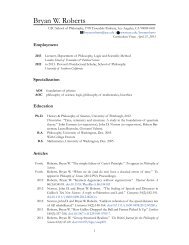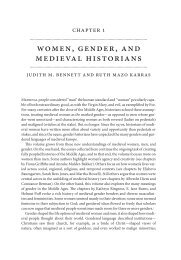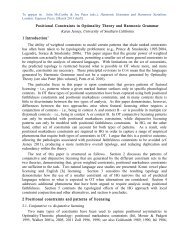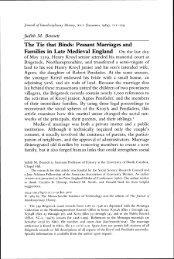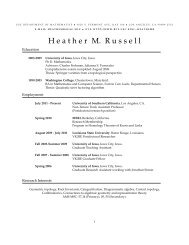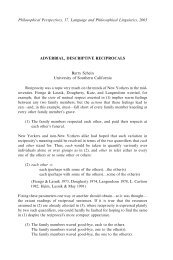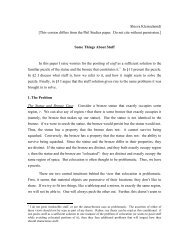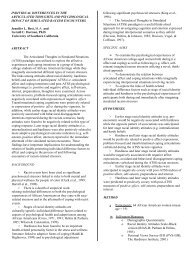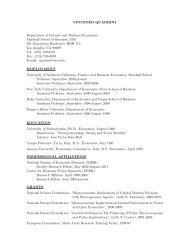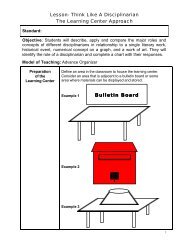Opposites Attract? Opportunities and Challenges for ... - Usc
Opposites Attract? Opportunities and Challenges for ... - Usc
Opposites Attract? Opportunities and Challenges for ... - Usc
You also want an ePaper? Increase the reach of your titles
YUMPU automatically turns print PDFs into web optimized ePapers that Google loves.
Rihoux <strong>and</strong> Marx 191<br />
<strong>Opposites</strong> <strong>Attract</strong>? <strong>Opportunities</strong> <strong>and</strong><br />
<strong>Challenges</strong> <strong>for</strong> Integrating Large-N QCA<br />
<strong>and</strong> Econometric Analysis<br />
Peer C. Fiss 1 , Dmitry Sharapov 2 , <strong>and</strong> Lasse Cronqvist 3<br />
DOI: 10.1177/1065912912468269e<br />
Abstract<br />
Contrasting insights that can be gained from large-N QCA <strong>and</strong> econometric analysis, we outline two novel ways<br />
to integrate both modes of inquiry. The first introduces QCA solutions into a regression model, while the second<br />
draws on recent work in lattice theory to integrate a QCA approach with a regression framework. These approaches<br />
allow researchers to test QCA solutions <strong>for</strong> robustness, address concerns regarding possible omitted variables,<br />
establish effect sizes, <strong>and</strong> test whether causal conditions are complements or substitutes, suggesting that an important<br />
way <strong>for</strong>ward <strong>for</strong> set-theoretic analysis lies in an increased dialogue that explores complementarities with existing<br />
econometric approaches.<br />
Introduction<br />
In its original statement by Charles Ragin (1987),<br />
Qualitative Comparative Analysis (QCA) was conceived<br />
as a methodology <strong>for</strong> small-N, comparative work in the<br />
case-oriented tradition; a conception that still resonates<br />
with much of the current work using QCA (Rihoux <strong>and</strong><br />
Ragin 2009). However, researchers have also applied<br />
QCA to examine large-N phenomena (e.g., Fiss 2011;<br />
Greckhamer, Misangyi, Elms, <strong>and</strong> Lacey 2008; Ragin<br />
<strong>and</strong> Fiss 2008; Vis 2012). 1 These large-N applications<br />
have prompted Greckhamer, Misangyi, <strong>and</strong> Fiss (<strong>for</strong>thcoming)<br />
to suggest that currently there are in fact “two<br />
QCAs” that differ in their focus on small- <strong>and</strong> large-N<br />
phenomena as well as in some of their assumptions,<br />
objectives, <strong>and</strong> analyses processes.<br />
Several issues are raised by applying QCA to a larger<br />
number of cases. In particular, researchers applying this<br />
approach find themselves largely on the same research<br />
terrain as traditional large-N researchers using econometric<br />
tools usually based on the st<strong>and</strong>ard linear model. We<br />
believe that this has proven to be both an opportunity <strong>and</strong><br />
a challenge. On the positive side, the application of QCA<br />
to large-N situations offers a considerable opportunity <strong>for</strong><br />
both new empirical insights <strong>and</strong> new theory building. For<br />
instance, prior works that focus on hypothesis testing in<br />
particular have tended to develop theories based on correlational<br />
statements. As Ragin (2000, 2008) has argued,<br />
such thinking does not necessarily correspond to the<br />
nature of causal relations present in social research.<br />
Accordingly, the introduction of QCA to a whole new<br />
series of phenomena carries a significant upside.<br />
However, this upside does not come without challenges.<br />
Chief among these is that in large-N QCA, it is difficult to<br />
maintain the kind of intimate familiarity with the cases<br />
that small-N QCA is usually based on. As a result, measurement<br />
errors in coding of cases are more likely.<br />
Contradictory observations in large-N QCA might then at<br />
times be accepted as measurement error, whereas in<br />
small-N QCA, they will frequently trigger a re-examination<br />
of the cases selected <strong>and</strong> whether all relevant causal conditions<br />
have been included. Due to this, establishing the<br />
robustness of QCA results is a more important concern in<br />
large-N applications than it is in small-N ones. In this<br />
article, we argue that there are two aspects in particular<br />
that need to be addressed <strong>for</strong> QCA to achieve its full<br />
potential as a method covering both small-N <strong>and</strong> large-N<br />
situations.<br />
The first issue relates to distinguishing the unique contribution<br />
of QCA relative to existing econometric tools<br />
when both could be used in large-N situations. To help<br />
realize QCA’s potential as a tool <strong>for</strong> large-N analysis, we<br />
briefly contrast large-N QCA with st<strong>and</strong>ard econometric<br />
approaches. This discussion is intended to lay the<br />
1 University of Southern Cali<strong>for</strong>nia, Los Angeles, USA<br />
2 University of Cambridge, UK<br />
3 University of Trier, Germany<br />
Downloaded from prq.sagepub.com at UNIV OF SOUTHERN CALIFORNIA on August 30, 2013
192 Political Research Quarterly 66(1)<br />
groundwork <strong>for</strong> the second issue, which focuses on<br />
potential synergies <strong>and</strong> ways to integrate the insights<br />
from QCA with other econometric tools. Specifically, we<br />
suggest that integrating QCA findings into a regression<br />
framework or a lattice-theoretic analysis that draws on<br />
recent work in lattice theory (Milgrom <strong>and</strong> Roberts 1990,<br />
1995; Mohnen <strong>and</strong> Röller 2005) to mimic a QCA<br />
approach within a regression framework potentially<br />
allows <strong>for</strong> added insights regarding result robustness,<br />
effect sizes, complementarity <strong>and</strong> substitutability relationships<br />
between causal conditions, <strong>and</strong> the addition of<br />
causal conditions that otherwise would make a QCA too<br />
unwieldy. We conclude by suggesting that one way <strong>for</strong>ward<br />
<strong>for</strong> set-theoretic analysis lies in an increased dialogue<br />
with existing econometric approaches.<br />
Contrasting Approaches: Large-N<br />
QCA versus Correlation-Based<br />
Approaches<br />
There is no question that QCA <strong>and</strong> correlation-based<br />
approaches such as linear regression are rather different<br />
beasts. As Ragin has argued, QCA should first <strong>and</strong> <strong>for</strong>emost<br />
be seen as a research strategy that emphasizes the<br />
dialogue of ideas <strong>and</strong> evidence, not merely a technique of<br />
analyzing data. But differences do not end there “settheoretic<br />
relations concern explicit connections, while<br />
correlations address tendential connections; set-theoretic<br />
relations are asymmetrical, while correlations are symmetrical;<br />
set-theoretic relations are well suited <strong>for</strong> questions<br />
about necessity <strong>and</strong> sufficiency, while correlations<br />
are not; <strong>and</strong> so on” (Ragin 2005, 37; emphasis in original,<br />
see also Achen 2005 <strong>and</strong> Seawright 2005 <strong>for</strong> alternative<br />
views). Along similar lines, Vis (2012) argues that while<br />
regression analysis strives to explain the average effects<br />
of certain variables (causes), QCA seeks to identify the<br />
causes of particular outcomes (effects).<br />
The contrasts between both approaches thus st<strong>and</strong> in<br />
fairly clear relief; however, there are also considerable<br />
similarities. As Greckhamer et al. (<strong>for</strong>thcoming) argue,<br />
large-N QCA is in fact well suited to hypothesis testing<br />
<strong>and</strong> deductive reasoning <strong>and</strong> by its very nature maintains<br />
a distance between the researcher <strong>and</strong> the cases, thus<br />
making large-N QCA applications in fact similar to conventional<br />
econometric approaches even as such QCA<br />
applications retain their configurational nature. Vis<br />
(2012), likewise, proposes that fuzzy-set QCA (fsQCA)<br />
moves toward identifying the effects of (multiple) causes<br />
rather than the causes of effects as the number of cases<br />
under study increases. To clarify this relationship, we<br />
contrast large-N QCA with st<strong>and</strong>ard econometric correlation-based<br />
approaches regarding their estimation procedures<br />
<strong>and</strong> their measures of model fit, with a focus on<br />
beginning a deeper engagement between these two<br />
approaches that are based on rather different epistemological<br />
<strong>and</strong> methodological assumptions.<br />
Contrasting Estimation Procedures<br />
QCA is a means of analyzing multiple cases to identify<br />
“recipes” of causal conditions associated with case membership<br />
in an outcome set (Ragin 2008). This approach<br />
allows <strong>for</strong> equifinality (different configurations leading<br />
to the same outcome), asymmetric causality (absence of<br />
causal conditions associated with an outcome not leading<br />
to absence of the outcome), <strong>and</strong> <strong>for</strong> differentiating<br />
between causally core <strong>and</strong> causally peripheral conditions<br />
(causally core conditions are part of both parsimonious<br />
<strong>and</strong> intermediate solutions, whereas causally peripheral<br />
conditions are part of the intermediate solution but are<br />
eliminated in the parsimonious one) (Fiss 2011; Ragin<br />
2000, 2008). In contrast, most basic econometric models<br />
are premised on what Ragin has termed “net effects<br />
thinking,” that is they estimate the impact of individual<br />
explanatory variables on a dependent variable, holding<br />
everything else constant. Such models implicitly assume<br />
unifinality, as the maximum value of the dependent variable<br />
is achieved by maximizing all explanatory variables<br />
that have positive coefficients, <strong>and</strong> symmetric causality,<br />
as the effect of a reduction in an explanatory variable on<br />
the outcome is equal <strong>and</strong> opposite to the effect of an<br />
increase of the same magnitude. Furthermore, many of<br />
these issues also apply to more advanced econometric<br />
approaches such as hierarchical linear models that aim to<br />
capture interactions across levels of analysis (e.g., Lacey<br />
<strong>and</strong> Fiss 2009).<br />
Although approaches such as interaction effects, cluster<br />
analysis, or deviation score analysis in combination<br />
with regression aim to overcome some of the liabilities of<br />
regression in analyzing configurations, each of these<br />
approaches faces significant shortcomings <strong>for</strong> researchers<br />
concerned with configurational analysis (e.g., Fiss<br />
2007, 2009). Interaction effects can be used to test asymmetric<br />
configurational hypotheses that correspond to<br />
notions of necessity <strong>and</strong> sufficiency in QCA (Clark,<br />
Gilligan, <strong>and</strong> Golder 2006), but their use tends to be limited<br />
to two-way or occasionally three-way effects as<br />
higher-order interactions are difficult to interpret <strong>and</strong> are<br />
likely to result in multicollinearity.<br />
In response, a newer class of regression-based<br />
approaches to the study of causally complex phenomena<br />
that has found some favor among political scientists is<br />
the partial observability probit approach proposed in<br />
Braumoeller (2003) <strong>and</strong> extended in Gordon <strong>and</strong> Smith<br />
(2004, 2005). In essence, these regression-based approaches<br />
allow researchers to statistically test theories proposing<br />
multiple causal paths by modeling the underlying causal<br />
Downloaded from prq.sagepub.com at UNIV OF SOUTHERN CALIFORNIA on August 30, 2013
Rihoux <strong>and</strong> Marx 193<br />
processes. The probability of occurrence of each causal<br />
factor is modeled as a function of a set of explanatory<br />
variables, <strong>and</strong> these probabilities are then multiplied<br />
together to get the overall probability that the event of<br />
interest will occur. Although these methods can usefully<br />
shed light on causal complexity in a variety of contexts,<br />
simulations have shown that the convergence, unbiasedness,<br />
<strong>and</strong> efficiency of the estimates that these methods<br />
produce is highly contingent both on the structure of the<br />
data used <strong>and</strong> on the accuracy of assumptions about the<br />
data generating process (Braumoeller <strong>and</strong> Kirpichevsky<br />
2005; Gordon <strong>and</strong> Smith 2004, 2005).<br />
Contrasting Measures of Fit<br />
Because the search <strong>for</strong> multicausal explanations is constitutive<br />
to the QCA approach, the main goal of the basic<br />
crisp-set QCA (csQCA) approach is to identify causes<br />
(or combinations of causes) that are common <strong>for</strong> cases<br />
exhibiting a certain outcome <strong>and</strong> to distinguish these<br />
cases from cases with a different outcome (Ragin 1987).<br />
Originally, no measurements of fit were included in the<br />
csQCA method. However, this changed with the introduction<br />
of consistency <strong>and</strong> coverage by Ragin (2006b,<br />
2008), which presented a move toward expressing the<br />
importance of solutions within QCA. Ragin defines consistency<br />
as “the degree to which the cases sharing a given<br />
combination of conditions . . . agree in displaying the<br />
outcome in question,” whereas coverage assesses “the<br />
degree to which a cause or causal combination ‘accounts<br />
<strong>for</strong>’ instances of an outcome.” (Ragin 2008, 44).<br />
Although these measurements can, to some extent, be<br />
used to qualify results of a csQCA analysis, they take on<br />
a more central role in fsQCA, as consistency is used to<br />
identify a subset of combination that exceed a given consistency<br />
threshold be<strong>for</strong>e reducing these combinations to<br />
identify more parsimonious solutions (Ragin 2008). By<br />
including the degree of consistency into the analysis<br />
itself, fsQCA introduces a measurement of fit based on<br />
set theory into the logic of QCA. Given the plethora of fit<br />
measures currently available to the skilled econometrician,<br />
it is not possible <strong>for</strong> us here to provide an extensive<br />
comparison between these fit measures <strong>and</strong> QCA-based<br />
fit measures. Instead, we focus on some basic differences<br />
in the nature of how fit is conceived in QCA. In particular,<br />
it is important to note that fsQCA applies a different<br />
criterion to determine “fit” than st<strong>and</strong>ard econometric<br />
analysis. Whereas, <strong>for</strong> example, an ordinary least squares<br />
(OLS)–based linear regression assumes a linear <strong>and</strong> thus<br />
symmetric relationship between independent <strong>and</strong> dependent<br />
variable, this is not the case in fsQCA, which<br />
assumes an asymmetric model of causality; in fsQCA,<br />
cases with a high value on a sufficient condition will<br />
always display high values of the outcome, but the inverse<br />
Figure 1. Relationship between condition <strong>and</strong> outcome fully<br />
consistent with sufficiency but with a low level of correlation<br />
in a regression analysis.<br />
is not the case; in fact, cases with a low value on the condition<br />
may display both high <strong>and</strong> low values on the outcome.<br />
In situations of perfect consistency, all cases will<br />
show higher or equal values <strong>for</strong> the outcome than <strong>for</strong> the<br />
conditions considered. This means that, contrary to a linear<br />
regression, a high degree of consistency with sufficiency<br />
is present even if many cases show much higher<br />
values <strong>for</strong> the outcome than <strong>for</strong> the condition in consideration,<br />
as shown in Figure 1.<br />
The fact that a data pattern such as the one shown in<br />
Figure 1 may be characterized by perfect consistency is a<br />
consequence of the multicausal notion of causality found<br />
in all varieties of QCA. In a linear regression, these cases<br />
would be assumed to contradict the underlying model,<br />
resulting in a low measurement of fit. In fsQCA, such<br />
cases showing a low value <strong>for</strong> the condition but a high<br />
value <strong>for</strong> the outcome indicate not so much “misfit” as<br />
they indicate an incomplete specification of the causal<br />
models; a different condition will have to be identified to<br />
account <strong>for</strong> the outcome in these cases.<br />
Due to its ability to distinguish between necessary<br />
<strong>and</strong> sufficient conditions, fsQCA is able to offer the<br />
researcher a comprehensive analysis of the relationship<br />
between a causal condition <strong>and</strong> an outcome in question.<br />
In fsQCA, sufficient conditions must be differentiated<br />
from necessary conditions; whereas the degree of sufficiency<br />
of a condition indicates how far a condition can<br />
be related to the explanation of an outcome, the degree of<br />
necessity indicates how far a condition is necessary <strong>for</strong><br />
an outcome to occur. Nonetheless, a data distribution<br />
showing a high measurement of fit in a regression analysis,<br />
as shown in Figure 2, will also show high levels of<br />
sufficiency as well as necessity with consistency in<br />
fsQCA.<br />
Downloaded from prq.sagepub.com at UNIV OF SOUTHERN CALIFORNIA on August 30, 2013
194 Political Research Quarterly 66(1)<br />
Figure 2. Relationship between causal condition <strong>and</strong><br />
outcome highly consistent with both necessity <strong>and</strong> sufficiency<br />
(>0.9) <strong>and</strong> a high level of correlation in a linear regression.<br />
Second, fsQCA offers a second measure of fit that<br />
assesses the coverage of a causal condition or a causal<br />
combination, thus providing an indicator of the scope of<br />
a causal condition in accounting <strong>for</strong> the outcome. This<br />
makes coverage comparable in spirit to coefficient of<br />
determination (R 2 ) that accounts <strong>for</strong> the proportion of<br />
variation in the outcome accounted <strong>for</strong> by the independent<br />
variables. However, it is again important to note<br />
that, unlike a correlation-based measure such as an R 2 ,<br />
coverage is an asymmetric measure. As such, coverage<br />
allows the researcher to assess how much of the variation<br />
in the outcome is accounted <strong>for</strong> by a causal condition.<br />
However, was the researcher to examine the inverse<br />
relationship—how much variation in the causal condition<br />
is accounted <strong>for</strong> by the outcome—a different value would<br />
be obtained.<br />
Integrating Approaches:<br />
<strong>Opportunities</strong> <strong>for</strong><br />
Complementary Insights<br />
So far, we have focused on contrasting the insights generated<br />
using a QCA approach with those using more<br />
st<strong>and</strong>ard econometric methods. It seems evident that the<br />
two approaches are based on rather different philosophies<br />
regarding the spirit <strong>and</strong> nature of social science<br />
research; we nevertheless see considerable opportunities<br />
<strong>for</strong> not only using both approaches in a contrasting manner<br />
but to draw on both approaches in an integrative<br />
manner. This would involve going beyond triangulation<br />
involving data analysis based on either approach <strong>and</strong><br />
comparing the results (e.g., Fiss 2011; Grofman <strong>and</strong><br />
Schneider 2009), <strong>and</strong> going toward developing hybrid<br />
methods incorporating elements from both approaches.<br />
While a full discussion of such methods is beyond the<br />
scope of this article, we want to provide an outline of<br />
what such integrative methods might look like <strong>and</strong> what<br />
insights they might provide.<br />
From the perspective of the large-N QCA researcher,<br />
there would appear to be at least two ways in which a<br />
regression-based approach might usefully be integrated<br />
with a set-theoretic approach. 2 The first one relates to the<br />
reintroduction of QCA solutions into a regression framework<br />
to test <strong>for</strong> robustness, establish effect sizes, <strong>and</strong><br />
address concerns regarding omitted variables in the QCA.<br />
The second one takes a slightly different approach by<br />
drawing on recent work in lattice theory to mimic a QCA<br />
approach within a regression framework to test <strong>for</strong> complementarity<br />
or substitutability between causal conditions.<br />
We now address each of these in turn.<br />
Using QCA Solutions<br />
in a Regression Framework<br />
When used in a large-N setting, there are in fact several<br />
ways in which QCA allows the researcher to either<br />
explore or test hypotheses about configurations that are<br />
sufficient to bring about the outcome in question, such as<br />
examining the sufficiency of a given combination using<br />
inferential statistics (e.g., Ragin 2000) or examining<br />
whether the consistency of an overall solution obtained<br />
by a truth table analysis exceeds a specified threshold. In<br />
addition, the researcher has the option of evaluating the<br />
necessity of either individual conditions or combinations<br />
of conditions. However, one of the strengths of the QCA<br />
approach—making explicit that the construction of sets<br />
crucially affects the results obtained—is also one of its<br />
weaknesses in the sense that it is frequently difficult to<br />
obtain stable results. At times, apparently small changes<br />
in calibration or the choice of cut-off values regarding<br />
frequency <strong>and</strong> consistency thresholds can precipitate<br />
significant changes in the solutions obtained (Skaaning<br />
2011). Although this is in principle no different from the<br />
situation faced in a correlational analysis, where trans<strong>for</strong>mation<br />
of variables, inclusion or exclusion of controls, or<br />
the choice of functional <strong>for</strong>m can likewise have significant<br />
effects on the results found, it still raises the question<br />
of how robustness checks might be constructed to<br />
validate the solutions obtained in a QCA. 3<br />
One possible way to create an integrated approach<br />
involves entering the solutions obtained by a QCA into a<br />
regression analysis. For instance, assume <strong>for</strong> simplicity’s<br />
sake that a fuzzy-set QCA has resulted in solution with<br />
two configurations that are sufficient to bring about the<br />
outcome: A•B•~C <strong>and</strong> A•~B•D. The researcher could<br />
then calculate the membership of each case in each configuration<br />
as the minimum across each of the three conditions<br />
involved, that is, min(A•B•~C) <strong>and</strong> min(A•~B•D),<br />
Downloaded from prq.sagepub.com at UNIV OF SOUTHERN CALIFORNIA on August 30, 2013
Rihoux <strong>and</strong> Marx 195<br />
<strong>and</strong> save the resulting values as new variables. These<br />
new variables, which now st<strong>and</strong> <strong>for</strong> the configurations<br />
obtained, can then be used in a st<strong>and</strong>ard regression analysis<br />
to predict the outcome in question. If the correlation<br />
between these newly created variables is quite high <strong>and</strong><br />
multicollinearity is thus a concern, the researcher could<br />
also choose to create an additional variable, which is the<br />
maximum across the two variables, following an approach<br />
commonly used in deviation score analysis that aims to<br />
assess overall fit (e.g., Doty et al. 1993). Alternatively,<br />
the researcher might create dummy variables coded 1 <strong>for</strong><br />
cases that have membership scores ≥0.5 in the configuration<br />
<strong>and</strong> thus present good instances of that corner of the<br />
multidimensional property space. The advantage of that<br />
approach is that it creates a stronger contrast to cases that<br />
have lower membership in both the configuration <strong>and</strong><br />
the outcome. Either way, a significant advantage of this<br />
approach is that the researcher can now estimate regression<br />
weights <strong>for</strong> paths obtained from a QCA <strong>and</strong> thus calculate<br />
the relative importance of each path. Because the<br />
outcome variable will normally also be a set <strong>and</strong> thus<br />
have restrictions in its range, a two-limit Tobit regression<br />
will usually be more appropriate than OLS regression<br />
when the dependent variable is truncated (Long 1997), as<br />
is the case with a fuzzy set.<br />
The approach described here also has an additional<br />
advantage in that it allows the researcher to introduce further<br />
control variables into the analysis—a key challenge<br />
<strong>for</strong> the large-N QCA researcher who is unlikely to have<br />
the same familiarity with each case as the small-N QCA<br />
researcher, thus raising the issue of whether omitted<br />
causal conditions may in fact be driving the findings. Of<br />
course, in a traditional QCA, the notion of “controls” is<br />
usually not part of the analysis, as QCA does not consider<br />
isolating <strong>and</strong> estimating independent effects of causal<br />
variables as the central goal of analysis but instead<br />
focuses on combinations of causally relevant conditions<br />
(e.g., Ragin 2005). However, this approach comes at a<br />
cost, as the inclusion of each additional causal condition<br />
exponentially increases the number of configurations that<br />
need to be examined, with more than ten conditions making<br />
the analysis rather unwieldy. In contrast, incorporating<br />
solutions into a regression analysis would allow QCA<br />
researchers to examine whether the solutions identified<br />
also hold up when other relevant control variables are<br />
entered along with these solutions into a regression<br />
model.<br />
The advantage of such a hybrid approach seems obvious,<br />
<strong>and</strong> we believe introducing such additional analyses<br />
would likely allow insights from large-N QCA to become<br />
more robust through comparison across methods <strong>and</strong><br />
more precise in assessing the magnitude of relationships.<br />
Of course, there are also tradeoffs, as this kind of hybrid<br />
approach moves the analysis much further into the direction<br />
of causal homogeneity <strong>and</strong> additivity—a direction that<br />
the QCA approach was designed to avoid. In particular,<br />
incorporating paths into a regression analysis means<br />
results obtained from an analysis based on set membership<br />
are now examined in an analysis based on correlation.<br />
For paths that are consistent with a sufficient set<br />
relation but low coverage, the regression analysis may be<br />
unlikely to show a significant correlation. Accordingly,<br />
paths that are qualitatively important but empirically rare<br />
may not be picked up by such an analysis, a fact that the<br />
researcher would need to take into account in an interpretation<br />
of the results as a robustness check. However,<br />
when used in addition to rather than as a substitute <strong>for</strong> the<br />
set-theoretic analysis <strong>and</strong> with an eye toward underst<strong>and</strong>ing<br />
the inherent differences in emphasis between both<br />
methods, these tradeoffs seem acceptable <strong>for</strong> the pragmatic<br />
researcher aiming to get a fuller view of the patterns<br />
inherent in the data under analysis.<br />
An Alternative Approach<br />
Based On Lattice Theory<br />
The approach we have discussed so far uses the results<br />
from a QCA to create variables <strong>for</strong> usage in a regression<br />
analysis, thus aiming to exploit the ability of a set-theoretic<br />
analysis to deal with complex causality <strong>and</strong> identify<br />
configurations that can then be analyzed using analyses<br />
based on the general linear model. However, another<br />
potential way of integrating QCA with econometrics is<br />
based on the mathematics of optimization of functions on<br />
lattices (Milgrom <strong>and</strong> Roberts 1990, 1995; Topkis<br />
1978). 4 Recently, this approach has been used to econometrically<br />
test <strong>for</strong> complementarity or substitutability<br />
between elements of a configuration by estimating the<br />
effects of configurations of binary explanatory variables<br />
on a dependent variable (Cassiman <strong>and</strong> Veugelers 2006;<br />
Mohnen <strong>and</strong> Röller 2005). Similarly to QCA, a latticetheoretic<br />
approach allows <strong>for</strong> the identification of necessary<br />
<strong>and</strong> sufficient conditions, equifinality, asymmetric<br />
causality, <strong>and</strong> <strong>for</strong> identifying causally core elements of<br />
the configuration. Furthermore, the ability to test <strong>for</strong><br />
complementarity between elements of the configuration<br />
may offer researchers a more fine-grained insight into<br />
what drives the association between configurations <strong>and</strong><br />
outcomes, <strong>and</strong> may help direct theory-building ef<strong>for</strong>ts<br />
toward underst<strong>and</strong>ing the mechanisms through which<br />
such complementarities come about. Finally, this<br />
approach can be used to check the robustness of QCA<br />
results to the inclusion of numerous control variables that<br />
may affect the outcome but could not be included as<br />
causal conditions in QCA. 5<br />
The key feature of the lattice-theoretic approach <strong>for</strong><br />
our purposes is its definition of complementarity between<br />
two activities. Suppose that an actor (such as a firm, a<br />
state, <strong>and</strong> a political party) engages in two activities, A<br />
<strong>and</strong> B, either or both of which it can choose to per<strong>for</strong>m.<br />
Downloaded from prq.sagepub.com at UNIV OF SOUTHERN CALIFORNIA on August 30, 2013
196 Political Research Quarterly 66(1)<br />
Accordingly, there are then four possible configurations<br />
of activities that the actor may end up choosing:<br />
Configuration 1: neither A nor B (~A•~B)<br />
Configuration 2: not A but B (~A•B)<br />
Configuration 3: A, but not B (A•~B)<br />
Configuration 4: both A <strong>and</strong> B (A•B)<br />
A <strong>and</strong> B are complementary in an outcome function<br />
V(.) if V(A•B) − V(~A•B) > V(A•~B) − V(~A•~B). To<br />
restate, A <strong>and</strong> B are complementary if the return to per<strong>for</strong>ming<br />
activity A is greater if activity B is already being<br />
per<strong>for</strong>med than if it is not. The above definition of complementarity<br />
also applies to set-theoretic logic if we take<br />
the consistency of solution membership in an outcome<br />
set Y as the outcome function V(.). Suppose that the configuration<br />
A•B is always a subset of the outcome of interest<br />
so its consistency is 100 percent, whereas the<br />
remaining three configurations are never subsets of the<br />
outcome with consistencies of 0 percent. Substituting<br />
these consistency values into the definition of complementarity<br />
given above we get: 100% (V(A•B))− 0%<br />
(V(~A•B)) > 0% (V(A•~B)) − 0% (V(~A•~B)). In this<br />
case, A <strong>and</strong> B are clearly complementary, but this is not<br />
particularly interesting as both A <strong>and</strong> B are necessary but<br />
insufficient conditions that must both be met to create the<br />
outcome.<br />
To see that knowing more about complementarity<br />
(or substitutability) relationships than QCA results can<br />
uncover might be worthwhile, let us slightly alter the<br />
above example by giving the solution A•~B a consistency<br />
score of .80. Substitution gives: 100% (V(A•B)) − 0%<br />
(V(~A•B)) > 80% (V(A•~B)) − 0% (V(~A•~B)). Again,<br />
A <strong>and</strong> B are clearly complementary, but this case is more<br />
interesting than the first one because QCA (assuming a<br />
consistency cut-off ≤ .80 <strong>and</strong> no remainders) would produce<br />
a parsimonious solution A → Y, suggesting that B<br />
has no influence on the outcome. However, this is not the<br />
case as the choice of B when A has already been chosen<br />
has the rather substantial effect of increasing the consistency<br />
of the solution from 80 to 100 percent.<br />
The lattice-theoretic approach has been used as the<br />
basis <strong>for</strong> econometric tests <strong>for</strong> complementarity in the<br />
field of innovation in the following manner (Mohnen<br />
<strong>and</strong> Röller 2005): First, a researcher runs the following<br />
regression analysis:<br />
V = β 1<br />
(~A•~B) + β 2<br />
(~A•B) + β 3<br />
(A•~B) +<br />
β 4<br />
(A•B) + γ’Z + ε,<br />
where V is the dependent variable, (~A•~B) <strong>and</strong> other<br />
possible configurations are binary dummy variables taking<br />
the value of 1 <strong>for</strong> observations in which these configurations<br />
are observed <strong>and</strong> 0 otherwise, β n<br />
(n = 1,2,3,4)<br />
are the estimates of the effect of these configurations on<br />
the dependent variable, conditional on a vector the control<br />
variables Z, <strong>and</strong> ε is an error term. 6 The dependent<br />
variable can be continuous, binary, or categorical.<br />
Like QCA, this specification allows <strong>for</strong> the identification<br />
of necessary <strong>and</strong> sufficient conditions, equifinality,<br />
asymmetric causality, <strong>and</strong> <strong>for</strong> identifying causally core<br />
conditions. If β 3<br />
is not significantly different from β 4<br />
, <strong>and</strong><br />
if both of these coefficients are larger than β 1<br />
<strong>and</strong> β 2<br />
(β 3<br />
≈β 4<br />
> β 1<br />
,β 2<br />
), then this is evidence that A is both a necessary<br />
<strong>and</strong> a sufficient condition <strong>for</strong> maximizing the<br />
probability of V occurring, conditional on the control<br />
variables Z. 7 Both A <strong>and</strong> B would appear to be necessary<br />
but insufficient conditions <strong>for</strong> V if β 4<br />
> β 1<br />
,β 2<br />
,β 3<br />
. Finally,<br />
if β 2<br />
≈β 3<br />
≈β 4<br />
>β 1<br />
, this suggests that both A <strong>and</strong> B are sufficient<br />
but unnecessary conditions <strong>for</strong> V.<br />
The results suggest equifinality if the difference<br />
between the largest <strong>and</strong> second-largest betas is not statistically<br />
significant. 8 If β 2<br />
≈β 3<br />
> β 1<br />
,β 4<br />
, this is evidence of<br />
asymmetric causality as the absence of a configuration<br />
associated with V (e.g., A•~B) will not necessarily lead to<br />
the absence of V. This is because (~A•B) is also associated<br />
with V. Furthermore, if β 3<br />
≈β 4<br />
> β 1<br />
,β 2<br />
, then A can be<br />
inferred to be a causally core condition, whereas B does<br />
not appear to affect the outcome (the QCA equivalent of<br />
this result would be a complex solution A•B + A•~B →<br />
V, which simplifies to a parsimonious solution A → V).<br />
The number of control variables to be included is the<br />
analysis limited solely by the degrees of freedom available<br />
in the data set, unlike QCA, where the number of causal<br />
conditions to be assessed faces greater constraints <strong>and</strong> “controlling”<br />
is usually not a goal of the analysis. If the estimated<br />
betas in the above regression are statistically significant <strong>and</strong><br />
are not all equal to each other, a test <strong>for</strong> complementarity<br />
between conditions A <strong>and</strong> B can be per<strong>for</strong>med.<br />
To test <strong>for</strong> complementarity, substitute the estimated<br />
betas from the above regression into the lattice-theoretic<br />
definition of complementarity: A <strong>and</strong> B are complementary<br />
if β 4<br />
− β 2<br />
> β 3<br />
− β 1<br />
. The statistic used to test whether<br />
this condition holds or not is a Wald distance test statistic,<br />
which corresponds to the minimum distance between the<br />
vector of estimated betas <strong>and</strong> a vector of hypothetical<br />
betas, which con<strong>for</strong>ms to the definition of complementarity.<br />
In practice this statistic is calculated by using the estimated<br />
betas <strong>and</strong> their variance–covariance matrix to<br />
solve a minimization problem with inequality constraints.<br />
9 Upper <strong>and</strong> lower bound critical values, which<br />
can be used to interpret this test statistic are given in<br />
Kodde <strong>and</strong> Palm (1986). In addition to testing the null<br />
hypothesis of complementarity, the null hypothesis of<br />
substitutability should also be tested. Doing so allows the<br />
researcher to see whether his data have the power to distinguish<br />
between the two hypotheses. This approach to<br />
testing <strong>for</strong> complementarity has been extended to test <strong>for</strong><br />
pairwise complementarity in a set of more than two configurational<br />
elements (Mohnen <strong>and</strong> Röller 2005), <strong>and</strong> can easily<br />
Downloaded from prq.sagepub.com at UNIV OF SOUTHERN CALIFORNIA on August 30, 2013
Rihoux <strong>and</strong> Marx 197<br />
be extended further to test <strong>for</strong> complementarity between<br />
combinations of numerous configurational elements.<br />
A limitation of the lattice-theoretic approach described<br />
above is that configurational elements must be in binary<br />
<strong>for</strong>m—either being used or not, with no allowance <strong>for</strong><br />
degrees of implementation, unlike fuzzy sets. A further<br />
significant limitation is that the approach requires observations<br />
on all possible configurations <strong>for</strong> complementarity<br />
testing to be possible. If the researcher is interested in<br />
numerous causal conditions relating to social phenomena,<br />
it is highly unlikely that a given data set will have<br />
observations on all possible configurations of these conditions.<br />
This commonly occurring lack of observations<br />
on some configurations of causal conditions, known as<br />
limited diversity to practitioners of QCA, presents perhaps<br />
the main opportunity <strong>and</strong> the main challenge <strong>for</strong><br />
integration of QCA with the lattice-theoretic approach.<br />
The potential <strong>for</strong> integration arises from QCA being<br />
equipped to deal with limited diversity through the use of<br />
easy <strong>and</strong> difficult counterfactuals (Ragin 2008), thereby<br />
allowing <strong>for</strong> the differentiation between causally core,<br />
causally peripheral, <strong>and</strong> irrelevant conditions (Fiss 2011).<br />
When not all logically possible configurations are<br />
observed in the data, preventing the researcher from<br />
using a lattice-theoretic approach, QCA counterfactual<br />
analysis could be used to identify conditions that appear<br />
to be causally core. If not all conditions are found to be<br />
causally core, the number of possible configurations of<br />
causally core conditions be analyzed using the latticetheoretic<br />
approach will be significantly lower than the<br />
number of configurations used in the QCA, <strong>and</strong> these<br />
configurations will be less likely to exhibit limited diversity.<br />
The lattice-theoretic approach could then be applied<br />
to test <strong>for</strong> complementarity between causally core conditions<br />
only, with noncore causal conditions being added to<br />
the set of control variables. QCA thus makes lattice-theoretic<br />
complementarity testing possible, <strong>and</strong> researchers<br />
using QCA may also benefit from following their analysis<br />
with a lattice-theoretic test of complementarity<br />
between core causal conditions to get insights about the<br />
relationship between the causal conditions <strong>and</strong> the outcome<br />
that could not be seen in the QCA results. In addition,<br />
the lattice-theoretic approach can also serve as a<br />
means of checking the robustness of QCA results to the<br />
inclusion of a large set of control variables <strong>and</strong> to the use<br />
of a continuous dependent variable.<br />
A limitation of this combined approach is that there is<br />
of course no guarantee that the narrowing down of the set<br />
of causal conditions to include only those identified as<br />
being causally core by QCA will result in data that do not<br />
exhibit limited diversity. In such cases, the lattice-theoretic<br />
approach may still serve a purpose as a robustness check,<br />
but it would not be possible to carry out the complementarity-testing<br />
procedure. Finally, this approach to integrating<br />
QCA <strong>and</strong> regression depends upon the QCA<br />
counterfactual analysis procedure to narrow down the set<br />
of causal conditions. Future work developing the hybrid<br />
QCA-lattice-theory approach should there<strong>for</strong>e investigate<br />
the extent to which the omission of control variables,<br />
which are to be used in the lattice-theoretic analysis, from<br />
the set of causal conditions included in the QCA stage<br />
may produce QCA results that fail to identify core causal<br />
conditions that affect the outcome in a configurational<br />
manner with one or more of the omitted variables.<br />
Conclusion<br />
As QCA researchers broaden their scope of inquiry to not<br />
only include small-N situations but also large-N situations,<br />
the changes in associated terrain <strong>and</strong> competition from<br />
established econometric approaches necessitate new ways<br />
to conceptualize set-theoretic inquiry. The goal of our<br />
article has been to facilitate this development <strong>and</strong> to provide<br />
some direction regarding this extension of the QCA<br />
approach as well as drawing out promising opportunities<br />
to engage <strong>and</strong> integrate with econometric methods. To the<br />
QCA purist, this might appear to be problematic, given the<br />
deep-running philosophical differences between the settheoretic<br />
<strong>and</strong> correlation-based approach; QCA is focused<br />
on the way that causal conditions combine, whereas<br />
regression analysis focuses on isolating net-effects. We do<br />
not wish to downplay these differences, <strong>and</strong> believe that<br />
our prior discussion has aimed to further clarify the relationship<br />
between QCA <strong>and</strong> correlation-based methods as<br />
both converge in their focus on large-N phenomena.<br />
Indeed, we believe that our argument <strong>for</strong> exploring the<br />
further integration of QCA <strong>and</strong> econometrics will only<br />
succeed if researchers are well aware <strong>and</strong> appreciative of<br />
these differences, as they are the basis <strong>for</strong> underst<strong>and</strong>ing<br />
the opportunities <strong>for</strong> complementarities between both<br />
approaches. Nevertheless, we feel that a push toward<br />
further potential integration <strong>and</strong> hybrid research strategies<br />
is in fact well founded on the pragmatic philosophy<br />
that underlies QCA <strong>and</strong> is reflected in its philosophy of<br />
engaging in a dialogue with the data. In our view, this<br />
integration presents an important <strong>and</strong> promising area of<br />
work that will require considerable methodological<br />
advancement. Much work remains, but we believe there<br />
is also much to be gained as we explore opportunities <strong>for</strong><br />
added insight drawing on the strengths of each approach.<br />
Notes<br />
1. Although Vis (2012) refers to fifty to hundred cases as<br />
“moderately large N,” we believe that settings with roughly<br />
hundred cases or more are commonly considered fully in (or<br />
almost fully in) the set of “large-N” studies.<br />
2. A number of integrative approaches that we do not discuss<br />
have been proposed. One particular integrative approach that<br />
appears to hold some promise is the use of QCA to create a<br />
meaningful typology of entities at one level of analysis<br />
Downloaded from prq.sagepub.com at UNIV OF SOUTHERN CALIFORNIA on August 30, 2013
198 Political Research Quarterly 66(1)<br />
be<strong>for</strong>e using dummy variables created according to this<br />
typology to account <strong>for</strong> contextual effects in a regression<br />
per<strong>for</strong>med at lower level of analysis. Dotti Sani <strong>and</strong> Quaranta<br />
(2011) use such an approach to study the work-motherhood<br />
relation in Organisation <strong>for</strong> Economic Co-operation <strong>and</strong><br />
Development (OECD) countries. Focusing on <strong>for</strong>mally<br />
accounting <strong>for</strong> measurement error, Eliason <strong>and</strong> Stryker<br />
(2009), in another approach, do use goodness-of-fit tests to<br />
qualify the fit of fuzzy-set conditions <strong>and</strong> thereby to adapt<br />
fsQCA results to inferential logic based on falsification.<br />
3. Maggetti <strong>and</strong> Levi-Faur (this issue) discuss strategies <strong>for</strong><br />
dealing with potential measurement error in QCA, whereas<br />
Emmenegger, Kvist, <strong>and</strong> Skaaning (this issue) review comparative<br />
welfare-state research using QCA <strong>and</strong> find that not<br />
all studies carried out robustness checks of their findings.<br />
4. Although the interested reader is encouraged to read these<br />
articles <strong>for</strong> a <strong>for</strong>mal treatment of optimization on lattices<br />
<strong>and</strong> <strong>for</strong> the relevant mathematical proofs, we shall focus our<br />
discussion of this approach on the results necessary <strong>for</strong> its<br />
econometric operationalization.<br />
5. The potential connection of lattice theory with (fs)QCA is<br />
also suggested by Zaytsev et al. (2012), who combine<br />
QCA with <strong>for</strong>mal concept analysis (FCA) based on lattice<br />
theory to address problems of measurement in democracy<br />
studies.<br />
6. The regression produces estimates <strong>for</strong> all four betas as it<br />
does not include a constant.<br />
7. If V is continuous, then this result suggests that A is a necessary<br />
<strong>and</strong> sufficient condition <strong>for</strong> high V. If β 3<br />
≈β 4<br />
< β 1<br />
,β 2<br />
then this would suggest that A is a necessary <strong>and</strong> sufficient<br />
condition <strong>for</strong> low V.<br />
8. If V is continuous, the above result would suggest equifinality<br />
with respect to a high V outcome. More generally<br />
<strong>for</strong> a continuous V, if the difference between two or more<br />
estimated betas is not statistically significant, these configurations<br />
are equifinal as they are mutually exclusive yet<br />
associated with the same value of the outcome variable.<br />
9. See Mohnen <strong>and</strong> Röller (2005) <strong>for</strong> details of the test statistic<br />
<strong>and</strong> of the inequality-constrained minimization problem<br />
used to calculate it.<br />
Dealing with Errors in QCA<br />
Martino Maggetti 1,2 <strong>and</strong> David Levi-Faur 3,4<br />
DOI: 10.1177/1065912912468269f<br />
Abstract<br />
This paper discusses five strategies to deal with five types of errors in Qualitative Comparative Analysis (QCA):<br />
condition errors, systematic errors, r<strong>and</strong>om errors, calibration errors, <strong>and</strong> deviant case errors. These strategies are<br />
the comparative inspection of complex, intermediary, <strong>and</strong> parsimonious solutions; the use of an adjustment factor, the<br />
use of probabilistic criteria, the test of the robustness of calibration parameters, <strong>and</strong> the use of a frequency threshold<br />
<strong>for</strong> observed combinations of conditions. The strategies are systematically reviewed, assessed, <strong>and</strong> evaluated as<br />
regards their applicability, advantages, limitations, <strong>and</strong> complementarities.<br />
Introduction: Errors<br />
<strong>and</strong> Criticisms of QCA<br />
Strategies to deal with the possibility of error are essential<br />
tools in all types of social research. The challenge of error<br />
management can be broadly conceived as the challenge of<br />
<strong>for</strong>ming a bridge between theory <strong>and</strong> empirical research<br />
in a world where some imprecision, uncertainty, <strong>and</strong> r<strong>and</strong>omness<br />
is unavoidable. Any research study in the social<br />
sciences must contend with error, stemming from a variety<br />
of sources, including incomplete definitions of the constructs<br />
being measured, imperfect operationalization of<br />
the ideas contained in the corresponding concepts, <strong>and</strong><br />
weaknesses of methods of assessment. This holds of<br />
course also <strong>for</strong> QCA, that, some argue, has limited capacity<br />
to deal with different types of errors that are commonplace<br />
in the social sciences. As QCA methods typically<br />
work under deterministic or quasi-deterministic assumptions,<br />
st<strong>and</strong>ard statistical techniques that are used to correct<br />
<strong>and</strong> minimize measurement error <strong>and</strong> other types of<br />
error do not apply. The researcher cannot straight<strong>for</strong>wardly<br />
1 University of Zurich, Switzerl<strong>and</strong><br />
2 University of Lausanne, Switzerl<strong>and</strong><br />
3 Hebrew University of Jerusalem, Israel<br />
4 Freie Universität Berlin, Germany<br />
Downloaded from prq.sagepub.com at UNIV OF SOUTHERN CALIFORNIA on August 30, 2013
230 Political Research Quarterly 66(1)<br />
methods. The topic of set-theoretic MMR involves more<br />
issues than we have discussed here. There are important<br />
differences between process tracing after a QCA of necessity,<br />
vs. a QCA of sufficiency. For example, sufficient<br />
solutions usually involve conjunctions <strong>and</strong>, in contrast to<br />
necessity, cases that reduce coverage are targets <strong>for</strong> process<br />
tracing (Schneider & Rohlfing <strong>for</strong>thcoming). Further<br />
exploration of these differences is a worthwhile<br />
endeavor to strengthen causal inferences in research on<br />
necessity <strong>and</strong> sufficiency alike.<br />
Notes<br />
1. See Eliason <strong>and</strong> Stryker (2009) <strong>for</strong> a different procedure<br />
<strong>for</strong> the analysis of necessary conditions. Dion (1998) uses<br />
a Bayesian approach <strong>for</strong> the analysis of necessary<br />
conditions.<br />
2. Rihoux <strong>and</strong> Lobe’s (2009) terms “upstream” <strong>and</strong> “downstream”—introduced<br />
in their discussion of the Qualitative<br />
Comparative Analysis (QCA) research process <strong>and</strong> the role<br />
of case knowledge therein—only partially overlap with ours.<br />
3. We say “main purpose” because, even in post-QCA process<br />
tracing, one might find hitherto overlooked evidence<br />
<strong>for</strong> changes in the population, concepts, measurement, <strong>and</strong><br />
calibration.<br />
4. We use this example <strong>for</strong> illustrative purposes only.<br />
5. As mentioned, MA alone is not necessary. We nevertheless<br />
start with a single condition to illustrate process tracing in<br />
the most basic setting of just one condition to identify<br />
potentially omitted terms.<br />
6. Using simulated data, an online appendix to our paper<br />
demonstrates that our <strong>for</strong>mulas produce plausible results<br />
(http://prq.sagepub.com/supplemental/).<br />
7. If the <strong>for</strong>mula nevertheless yields the same score <strong>for</strong> multiple<br />
cases, one should choose the one with higher membership<br />
in Y.<br />
8. This holds true because the logical OR operator requires<br />
assigning cases the maximum set membership across all<br />
conditions combined by logical OR (Ragin 2000, 175).<br />
9. Alternatively, they contribute to the trivialness of the necessary<br />
condition (Goertz 2006; Ragin 2006; Schneider <strong>and</strong><br />
Wagemann 2012).<br />
10. Pre-QCA studies of cases in Zone 3 might help to identify<br />
measurement <strong>and</strong>/or calibration error in either X (membership<br />
too easy) or Y (membership too difficult) <strong>and</strong> increase<br />
the relevance of X. These are not model-related modifications<br />
as we define them, though.<br />
11. Goertz (2008, 11) calls this “choosing cases diversely.”<br />
12. Typical cases that are joint members should only be chosen<br />
if no unique members are available.<br />
13. This selection strategy is the set-theoretic equivalent to<br />
the diverse case strategy (Seawright <strong>and</strong> Gerring 2008;<br />
Rohlfing 2012, chap. 3).<br />
14. If two or more pairs of cases obtain the same score,<br />
researchers should choose the one with the largest difference<br />
in Y.<br />
15. We know that the entire truth table row to which the typical<br />
case belongs is sufficient <strong>for</strong> the outcome. Every condition<br />
constituting this row is an INUS condition, <strong>and</strong><br />
taking away any of these conditions might lead to the<br />
absence of the outcome (assuming that we analyze unique<br />
members <strong>and</strong> that the condition is not logically redundant).<br />
Consequently, case selection <strong>for</strong> comparative process<br />
tracing in the typical case <strong>and</strong> the IIR case must<br />
ensure that all INUS conditions are present in these cases.<br />
16. Note that <strong>for</strong> process tracing on the mechanism behind the<br />
pattern of necessity, it only matters that cases are members<br />
of similar truth table rows, not how strong their membership<br />
in these rows are.<br />
17. If two or more pairs of cases obtain the same score,<br />
researchers should choose the one with the largest difference<br />
in Y.<br />
18. See the truth table in the online appendix (http://prq.sagepub.com/supplemental/).<br />
19. If two or more pairs of cases obtain the same score,<br />
researchers should choose the one with the largest sum of<br />
membership scores in Y.<br />
20. In the ideal scenario, the deviant cases consistency turn<br />
into typical cases if we were to add the omitted term to the<br />
solution.<br />
21. If two or more pairs of cases obtain the same score,<br />
researchers should choose the one with the largest difference<br />
in Y.<br />
Acknowledgements<br />
The editors wish to thank Priscilla Álamos-Concha <strong>for</strong> her help<br />
in the fine-tuning of the manuscript.<br />
Declaration of Conflict Interests<br />
The authors declared no potential conflicts of interest with<br />
respect to the research, authorship, <strong>and</strong>/or publication of this<br />
article.<br />
Funding<br />
The authors disclosed receipt of the following financial support<br />
<strong>for</strong> the research, authorship, <strong>and</strong>/or publication of this article:<br />
Charles Ragin acknowledges support from the National Science<br />
Foundation: NSF SciSIP <strong>and</strong> STS Programs, award #1057559.<br />
References<br />
Abell, Peter. 1990. “Supporting Industrial Cooperatives in<br />
Developing Countries: Some Tanzanian Experiences.” Economic<br />
<strong>and</strong> Industrial Democracy 11 (4): 483–504.<br />
Achen, Christopher. 2005. “Two Cheers <strong>for</strong> Charles Ragin.” Studies<br />
in Comparative International Development 40 (1): 27–32.<br />
Aleman, José. 2009. “The Politics of Tripartite Cooperation in<br />
New Democracies: A Multi-level Analysis.” International<br />
Political Science Review 30 (2): 141–62.<br />
Alon, Sigal. 2007. “Overlapping Disadvantages <strong>and</strong> the Racial/<br />
Ethnic Graduation Gap among Students Attending Selective<br />
Institutions.” Social Science Research 36 (4): 1475–99.<br />
Downloaded from prq.sagepub.com at UNIV OF SOUTHERN CALIFORNIA on August 30, 2013
Rihoux <strong>and</strong> Marx 231<br />
Amenta, Edwin, Neal Caren, <strong>and</strong> Sheera J. Olaski. 2005. “Age<br />
<strong>for</strong> Leisure? Political Mediation <strong>and</strong> the Impact of the Pension<br />
Movement on US Old-Age Policy.” American Sociological<br />
Review 70 (3): 516–38.<br />
Amenta, Edwin, Bruce G. Carruthers, <strong>and</strong> Yvonne Zylan. 1992.<br />
“A Hero <strong>for</strong> the Aged? The Townsend Movement, the<br />
Political Mediation Model, <strong>and</strong> U.S. Old-Age Policy, 1934–<br />
1950.” American Journal of Sociology 98 (2): 308–39.<br />
Amenta, Edwin, <strong>and</strong> Drew Halfmann. 2000. “Wage Wars:<br />
Institutional Politics, WPA Wages, <strong>and</strong> the Struggle <strong>for</strong><br />
U.S. Social Policy.” American Sociological Review 65 (4):<br />
506–28.<br />
Amenta, Edwin, <strong>and</strong> Alex<strong>and</strong>er Hicks. 2010. “Research Methods.”<br />
In The Ox<strong>for</strong>d H<strong>and</strong>book of the Welfare State, edited<br />
by Francis Castles, Stephan Leibfried, Jane Lewis, Herbert<br />
Obinger, <strong>and</strong> Christopher Pierson, 105–20. Ox<strong>for</strong>d: Ox<strong>for</strong>d<br />
University Press.<br />
Amenta, Edwin, <strong>and</strong> Jane D. Poulsen. 1994. “Where to Begin.”<br />
Sociological Methods & Research 23 (1): 22–53.<br />
Amenta, Edwin, <strong>and</strong> Jane D. Poulsen. 1996. “Social Politics<br />
in Context: The Institutional Politics Theory <strong>and</strong> Social<br />
Spending at the End of the New Deal.” Social Forces 75<br />
(1): 33–60.<br />
Avdagic, Sabina. 2010. “When Are Concerted Re<strong>for</strong>ms Feasible?<br />
Explaining the Emergence of Social Pacts in Western<br />
Europe.” Comparative Political Studies 43 (5): 628–57.<br />
Bennett, Andrew, Aharon Barth, <strong>and</strong> Kenneth R. Ruther<strong>for</strong>d.<br />
2003. “Do We Preach What We Practice? A Survey of<br />
Methods in Political Science Journals <strong>and</strong> Curricula.” Political<br />
Science <strong>and</strong> Politics 36 (3): 373–8.<br />
Berg-Schlosser, D., <strong>and</strong> Gisèle De Meur. 2009. Comparative<br />
Research Design: Case <strong>and</strong> Variable Selection. In Configurational<br />
Comparative Methods. Qualitative Comparative<br />
Analysis (QCA) <strong>and</strong> Related Techniques, edited by Benoît<br />
Rihoux <strong>and</strong> Charles Ragin, 19–32. Thous<strong>and</strong> Oaks: SAGE.<br />
Berg-Schlosser, D., Gisèle De Meur, Benoît Rihoux, <strong>and</strong><br />
Charles Ragin. 2009. “Qualitative Comparative Analysis<br />
(QCA) as an Approach.” In Configurational Comparative<br />
Methods. Qualitative Comparative Analysis (QCA) <strong>and</strong><br />
Related Techniques, edited by Benoît Rihoux <strong>and</strong> Charles<br />
Ragin, 1–18. Thous<strong>and</strong> Oaks: SAGE.<br />
Blake, Charles H., <strong>and</strong> Jessica R. Adolino. 2001. “The Enactment<br />
of National Health Insurance: A Boolean Analysis<br />
of Twenty Advanced Industrial Democracies.” Journal of<br />
Heath Politics, Policy, <strong>and</strong> Law 26 (4): 679–708.<br />
Blatter, Joachim, Matthias Kreutzer, Michaela Rentl, <strong>and</strong> Jan<br />
Thiele. 2009. “Preconditions <strong>for</strong> Foreign Activities of European<br />
Regions: Tracing Causal Configurations of Economic,<br />
Cultural, <strong>and</strong> Political Strategies.” Publius: The Journal of<br />
Federalism 40:171–99.<br />
Bleijenbergh, Inge, <strong>and</strong> Conny Roggeb<strong>and</strong>. 2007. “Equality<br />
Machineries Matter: The Impact of Women’s Political<br />
Pressure on European Social-Care Policies.” Social Politics:<br />
International Studies in Gender, State <strong>and</strong> Society 14 (4):<br />
437–59.<br />
Bochsler, Daniel. 2011. “It Is Not How Many Votes You Get,<br />
But Also Where You Get Them: Territorial Determinants <strong>and</strong><br />
Institutional Hurdles <strong>for</strong> the Success of Ethnic Minority Parties<br />
in Post-Communist Countries.” Acta Politica 46:217–38.<br />
Braumoeller, Bear F. 2003. “Causal Complexity <strong>and</strong> the Study<br />
of Politics.” Political Analysis 11:209–33.<br />
Braumoeller, Bear F., <strong>and</strong> Gary Goertz. 2000. “The Methodology<br />
of Necessary Conditions.” American Journal of Political<br />
Science 44 (4): 844–58.<br />
Braumoeller, Bear F., <strong>and</strong> Yevgeniy Kirpichevsky. 2005.<br />
“When More Is Less: Integrating Qualitative In<strong>for</strong>mation<br />
<strong>and</strong> Boolean Statistics.” Political Analysis 13:261–79.<br />
Cassiman, Bruno, <strong>and</strong> R. Veugelers. 2006. “In Search of Complementarity<br />
in Innovation Strategy: Internal R&D <strong>and</strong> External<br />
Knowledge Acquisition.” Management Science 52:68–82.<br />
Chanson, Guillaume, Benoît Demil, Xavier Lecocq, <strong>and</strong> Pierre-<br />
Antoine Sprimont. 2005. “La place de l’analyse qualitative<br />
comparée en sciences de gestion” [The place of qualitative<br />
comparative analysis in management sciences]. Finance<br />
Contrôle Stratégie 3 (8): 29–50.<br />
Chiappero-Martinetti, Enrica. 2000. “A Multidimensional<br />
Assessment of Well-Being Based on Sen’s Functioning<br />
Approach.” Rivista Internazionale di Scienze Sociali<br />
2:207–39.<br />
Clark, William R., Michael Gilligan, <strong>and</strong> Matt Golder. 2006.<br />
“A Simple Multivariate Test <strong>for</strong> Asymmetric Hypotheses.”<br />
Political Analysis 14 (3): 311–31.<br />
Collier, David, <strong>and</strong> Robert Adcock. 1999. “Democracy <strong>and</strong><br />
Dichotomies: A Pragmatic Approach to Choices about Concepts.”<br />
Annual Review of Political Science 1:537–65.<br />
COMPASSS. 2011. “International Bibliographical Database.”<br />
http://www.compasss.org/pages/resources/international.html.<br />
Cronqvist, Lasse. 2011. Tosmana: Tool <strong>for</strong> Small-N Analysis.<br />
Trier, Germany: Department of Political Science, University<br />
of Trier.<br />
Cronqvist, Lasse, <strong>and</strong> Dirk Berg-Schlosser. 2009. “Multi-value<br />
QCA (MVQCA).” In Configurational Comparative Methods.<br />
Qualitative Comparative Analysis (QCA) <strong>and</strong> Related<br />
Techniques, Applied Social Research Methods, edited by<br />
B. Rihoux <strong>and</strong> C. C. Ragin, 69–86, 167–77. Thous<strong>and</strong><br />
Oaks: SAGE.<br />
Cronqvist, Lasse. 2011. Tosmana: Tool <strong>for</strong> Small-N Analysis.<br />
Trier, Germany: Department of Political Science, University<br />
of Trier.<br />
De Meur, Gisèle, <strong>and</strong> Benoît Rihoux, eds. 2002. L’analyse<br />
quali-quantitative comparée (AQQC-QCA): Approche,<br />
techniques et applications en sciences humaines. Louvainla-Neuve,<br />
Belgium: Academia-Bruylant.<br />
De Meur, Gisèle, Benoît Rihoux, <strong>and</strong> Sakura Yamasaki. 2009.<br />
“Addressing the Critiques of csQCA.” In Configurational<br />
Comparative Methods. Qualitative Comparative Analysis<br />
(QCA) <strong>and</strong> Related Techniques, edited by Benoît Rihoux<br />
<strong>and</strong> Charles Ragin, 139–60. Thous<strong>and</strong> Oaks: SAGE.<br />
Dion, Douglas. 1998. “Evidence <strong>and</strong> Inference in the Comparative<br />
Case Study.” Comparative Politics 30:127–45.<br />
Downloaded from prq.sagepub.com at UNIV OF SOUTHERN CALIFORNIA on August 30, 2013
232 Political Research Quarterly 66(1)<br />
Dotti Sani, Giulia M., <strong>and</strong> Mario Quaranta. 2011. “A Mixed<br />
Approach to Work-Motherhood Relation in OECD Countries.”<br />
Paper prepared <strong>for</strong> presentation at the 6th General<br />
European Consortium of Political Science Conference,<br />
Panel “Mixed Methods.” August 25–27, 2011, University<br />
of Icel<strong>and</strong>, Reykjavik.<br />
Doty, D. Horald, W. H. Glick, <strong>and</strong> G. P. Huber. 1993. “Fit,<br />
Equifinality, <strong>and</strong> Organizational Effectiveness: A Test of<br />
Two Configurational Theories.” Academy of Management<br />
Journal 36:1196–250.<br />
Drass, Kriss A., <strong>and</strong> J. William Spencer. 1987. “Accounting <strong>for</strong><br />
Pre-Sentencing Recommendations: Typologies <strong>and</strong> Probation<br />
Officers’ Theory of Office.” Social Problems 34 (3):<br />
277–93.<br />
Dul, Jan, Tony Hak, Gary Goertz, <strong>and</strong> Chris Voss. 2010. “Necessary<br />
Condition Hypotheses in Operations Management.”<br />
International Journal of Operations & Production Management<br />
30 (11): 1170–90.<br />
Dusa, Adrian, <strong>and</strong> Alrik Thiem. 2012. “QCA: Qualitative Comparative<br />
Analysis. R Package Version 1.0-3.”<br />
Ebbinghaus, Bernhard. 2005. “When Less is More.” International<br />
Sociology 20:133–52.<br />
Eliason, Scott, <strong>and</strong> R. Stryker. 2009. “Goodness-of-Fit Tests<br />
<strong>and</strong> Descriptive Measures in Fuzzy-Set Analysis.” Sociological<br />
Methods & Research 38:102–46.<br />
Emmenegger, Patrick. 2008. “Religion und Arbeitnehmerschutzgesetzgebung:<br />
Eine Fuzzy-Set Analyse” [Religion<br />
<strong>and</strong> employment protection legislation: A fuzzy-set analysis].<br />
Swiss Political Science Review 14 (1): 85–130.<br />
Emmenegger, Patrick. 2011. “Job Security Regulations in<br />
Western Democracies: A Fuzzy Set Analysis.” European<br />
Journal of Political Research 50 (3): 336–64.<br />
Emmenegger, Patrick. 2012. “How Good Are Your Counterfactuals?<br />
Assessing Quantitative Macro-Comparative Welfare<br />
State Research with Qualitative Criteria.” Journal of European<br />
Social Policy 21:365–80.<br />
Fiss, Peer C. 2007. “A Set-Theoretic Approach to Organizational<br />
Configurations.” Academy of Management Review<br />
32:1180–98.<br />
Fiss, Peer C. 2009. “Case Studies <strong>and</strong> the Configurational Analysis<br />
of Organizational Phenomena.” In H<strong>and</strong>book of Case<br />
Study Methods, edited by Charles Ragin <strong>and</strong> David Byrne,<br />
424–40. London: SAGE.<br />
Fiss, Peer C. 2011. “Building Better Causal Theories: A Fuzzy<br />
Set Approach to Typologies in Organizational Research.”<br />
Academy of Management Journal 54 (2): 393–420.<br />
Franchino, Fabio. 2005. “The Study of EU Public Policy:<br />
Results of a Survey.” European Union Politics, Forum Section<br />
6 (2): 243–52.<br />
George, Alex<strong>and</strong>er L., <strong>and</strong> Andrew Bennett. 2005. Case Studies<br />
<strong>and</strong> Theory Development in the Social Sciences. London:<br />
MIT Press.<br />
Gjølberg, Maria. 2009. “The Origin of Corporate Social<br />
Responsibility: Global Forces or National Legacies.” Socio-<br />
Economic Review 7 (4): 605–37.<br />
Glaesser, Judith. 2008. “Just How Flexible is the German<br />
Selective Secondary School System? A Configurational<br />
Analysis.” International Journal of Research & Method in<br />
Education 31 (2): 193–209.<br />
Goertz, Gary. 2006. “Assessing the Trivialness, Relevance, <strong>and</strong><br />
Relative Importance of Necessary or Sufficient Conditions<br />
in Social Science.” Studies in Comparative International<br />
Development (SCID) 41 (2): 88–109.<br />
Goertz, Gary. 2008. “Choosing Cases <strong>for</strong> Case Studies: A Qualitative<br />
Logic.” Newsletter of the APSA Section on Qualitative<br />
& Multi-Method Research 6 (2): 11–4.<br />
Goertz, Gary, <strong>and</strong> James Mahoney. 2005. “Negative Case Selection:<br />
The Possibility Principle.” In Social Science Concepts:<br />
A User’s Guide, edited by Gary Goertz, 177–210. Princeton:<br />
Princeton University Press.<br />
Goertz, Gary, <strong>and</strong> Harvey Starr. 2003. “Introduction: Necessary<br />
Condition Logics, Research Design, <strong>and</strong> Theory.” In Necessary<br />
Conditions: Theory, Methodology, <strong>and</strong> Applications,<br />
edited by Gary Goertz <strong>and</strong> Harvey Starr, 1–24. New-York:<br />
Rowman <strong>and</strong> Littlefield.<br />
Goldthorpe, John H. 1997. “Current Issues in Comparative<br />
Macrosociology: A Debate on Methodological Issues.”<br />
Comparative Social Research 16:1–26.<br />
Gordon, San<strong>for</strong>d C., <strong>and</strong> Alastair Smith. 2004. “Quantitative<br />
Leverage through Qualitative Knowledge: Augmenting the<br />
Statistical Analysis of Complex Causes.” Political Analysis<br />
12:233–55.<br />
Gordon, San<strong>for</strong>d C., <strong>and</strong> Alastair Smith. 2005. “Qualitative<br />
Leverage <strong>and</strong> the Epistemology of Expert Opinion.” Political<br />
Analysis 13:280–91.<br />
Greckhamer, Thomas. 2011. “Cross-Cultural Differences in<br />
Compensation Level <strong>and</strong> Inequality across Occupation:<br />
A Set-Theoretic Analysis.” Organization Studies 32 (1):<br />
85–115.<br />
Greckhamer, Thomas, Vilmos Misangyi, Heather Elms, <strong>and</strong><br />
Rodney Lacey. 2008. “Using Qualitative Comparative<br />
Analysis in Strategic Management Research: An Examination<br />
of Combinations of Industry, Corporate, <strong>and</strong> Business-<br />
Unit Effects.” Organizational Research Methods 11:<br />
695–726.<br />
Greckhamer, Thomas, Vilmos Misangyi, <strong>and</strong> Peer Fiss. Forthcoming.<br />
“The Two QCAs: Small- <strong>and</strong> Large-N Comparative<br />
Approaches in Organization Studies.” In Research in<br />
Sociology of Organizations, edited by Peer Fiss, Bart Cambré,<br />
<strong>and</strong> Axel Marx. Emerald Publishers<br />
Grofman, Bernard, <strong>and</strong> Carsten Q. Schneider. 2009. “An<br />
Introduction to Crisp Set QCA, with a Comparison to<br />
Binary Logistic Regression.” Political Research Quarterly<br />
62:662–72.<br />
Herrmann, Andrea M., <strong>and</strong> L. Cronqvist. 2009. “When Dichotomisation<br />
becomes a Problem <strong>for</strong> the Analysis of Middle-<br />
Sized Datasets.” International Journal of Social Research<br />
Methodology 12 (1): 33–50.<br />
Hicks, Alex<strong>and</strong>er M. 1994. “Qualitative Comparative Analysis<br />
<strong>and</strong> Analytical Induction: The Case of the Emergence of the<br />
Downloaded from prq.sagepub.com at UNIV OF SOUTHERN CALIFORNIA on August 30, 2013
Rihoux <strong>and</strong> Marx 233<br />
Social Security State.” Sociological Methods & Research<br />
23:86–113.<br />
Hicks, Alex<strong>and</strong>er, Joya Mishra, <strong>and</strong> Tang Nah Ng. 1995. “The<br />
Programmatic Emergence of the Social Security State.”<br />
American Sociological Review 60 (3): 329–49.<br />
Hudson, John, <strong>and</strong> Stefan Kühner. 2010. “Beyond the<br />
Dependent Variable Problem: The Methodological <strong>Challenges</strong><br />
of Capturing Productive <strong>and</strong> Protective Dimensions<br />
of Social Policy.” Social Policy <strong>and</strong> Society 9 (2):<br />
167–79.<br />
Hug, Simon. 2012. “Limitations of QCA.” APSA—Comparative<br />
Politics Newsletter 22 (1): 6.<br />
Jang, Dong-Ho. 2009. “Significance of Variations between<br />
Income Transfers <strong>and</strong> Social Care Services Development.”<br />
Journal of Comparative Social Welfare 25 (1): 37–48.<br />
Janoski, Thomas, <strong>and</strong> Alex<strong>and</strong>er Hicks. 1994. The Comparative<br />
Political Economy of the Welfare State. Cambridge: Cambridge<br />
University Press.<br />
Jordan, Elizabeth, Martha Gross, Amy Nicole Javernick-Will,<br />
<strong>and</strong> Michael Arvin. 2011. “Use <strong>and</strong> Misuse of Qualitative<br />
Comparative Analysis.” Construction Management <strong>and</strong><br />
Economics 29 (11): 1159–73.<br />
Kenworthy, Lane, <strong>and</strong> Alex<strong>and</strong>er Hicks. 2008. Method <strong>and</strong><br />
Substance in Macrocomparative Analysis. New Hampshire:<br />
Palgrave Macmillan.<br />
Kim, Kyo-seong, <strong>and</strong> Yeon Jung Lee. 2008. “A Qualitative<br />
Comparative Analysis of Strategies <strong>for</strong> an Ageing Society,<br />
with Special Reference to Pension <strong>and</strong> Employment Policies.”<br />
International Journal of Social Welfare 17:225–35.<br />
Kittel, Bernhard, Herbert Obinger, <strong>and</strong> Uwe Wagschal. 2000.<br />
“Die gezügelten Wohlfahrtsstaaten im international Vergleich”<br />
[The tamed welfare state in international comparative<br />
perspective]. In Der gezügelte Wohlfahrtsstaat, edited<br />
by Herbert Obinger <strong>and</strong> Uwe Wagschal, 329–64. Frankfurt,<br />
Germany: CAMPUS.<br />
Kodde, David A., <strong>and</strong> F. C. Palm. 1986. “Wald Criteria <strong>for</strong><br />
Jointly Testing Equality <strong>and</strong> Inequality Restrictions.”<br />
Econometrica 54:1243–8.<br />
Koenig-Archibugi, Mathias. 2004. “Explaining Government<br />
Preferences <strong>for</strong> Institutional Change in EU Foreign <strong>and</strong><br />
Security Policy.” International Organization 58 (1): 137–74.<br />
Kogut, Bruce, <strong>and</strong> Charles Ragin. 2006. “Exploring Complexity<br />
When Diversity is Limited: Institutional Complementarity<br />
in Theories of Rule of Law <strong>and</strong> National Systems<br />
Revisited.” European Management Review 3 (1): 44–59.<br />
Kvist, Jon. 1999. “Welfare Re<strong>for</strong>m in the Nordic Countries in<br />
the 1990s: Using Fuzzy-Set Theory to Assess Con<strong>for</strong>mity<br />
to Ideal Types.” Journal of European Social Policy 9 (3):<br />
231–52.<br />
Kvist, Jon. 2007. “Fuzzy Set Ideal Type Analysis.” Journal of<br />
Business Research 60 (5): 474–81.<br />
Lacey, Rodney, <strong>and</strong> P. C. Fiss. 2009. “Comparative Organizational<br />
Analysis across Multiple Levels: A Set-Theoretic<br />
Approach.” In Research in the Sociology of Organizations:<br />
Comparative Approaches to Organizational Research,<br />
edited by Brayden King, Teppo Felin, <strong>and</strong> David Whetten,<br />
91–116. Bingley, UK: Emerald Publishers.<br />
Lebow, Richard Ned. 2010. Forbidden Fruit: Counterfactuals<br />
<strong>and</strong> International Relations. Princeton: Princeton University<br />
Press.<br />
Lee, Sophia Seung-yoon. 2011. Fuzzy-Set Method in Comparative<br />
Social Policy: A Critical Introduction <strong>and</strong> Review of<br />
the Applications of the Fuzzy-Set Method. Quality & Quantity<br />
45:1–18.<br />
Lieberman, Evan S. 2005. “Nested Analysis as a Mixed-Method<br />
Strategy <strong>for</strong> Comparative Research.” American Political<br />
Science Review 99:435–52.<br />
Lieberson, Stanley. 1991. “Small N’s <strong>and</strong> Big Conclusions:<br />
An Examination of the Reasoning in Comparative Studies<br />
Based On a Small Number of Cases.” Social Forces 70:<br />
307–20.<br />
Lieberson, Stanley. 1994. “More on the Uneasy Case <strong>for</strong> Using<br />
Mill-Type Methods in Small N Comparative Studies.”<br />
Social Forces 72:1225–37.<br />
Lieberson, Stanley. 2004. “Comments on the Use <strong>and</strong> Utility of<br />
QCA.” Qualitative Methods 2 (2): 13–4.<br />
Lipset, Seymour Martin. 1959. “Some Social Requisites of<br />
Democracy: Economic Development <strong>and</strong> Political Legitimacy.”<br />
American Political Science Review 53:69–105.<br />
Long, J. Scott. 1997. Regression Models <strong>for</strong> Categorical <strong>and</strong><br />
Limited Dependent Variables. Thous<strong>and</strong> Oaks: SAGE.<br />
Longest, Kyle C., <strong>and</strong> Stephen Vaisey. 2008. “Fuzzy: A Program<br />
<strong>for</strong> Per<strong>for</strong>ming Qualitative Comparative Analysis<br />
(QCA) in Stata.” The State Journal 8 (1): 79–104.<br />
Maggetti, Martino. 2007. “De Facto Independence after Delegation:<br />
A Fuzzy-Set Analysis.” Regulation & Governance<br />
1 (4): 271–94.<br />
Maggetti, Martino. 2012. Regulation in Practice. Colchester,<br />
Engl<strong>and</strong>: ECPR Press.<br />
Mahoney, James, Erin Kimball, <strong>and</strong> Kendra L. Koivu. 2009.<br />
“The Logic of Historical Explanation in the Social Sciences.”<br />
Comparative Political Studies 42 (1): 114–46.<br />
Marx, Axel. 2010. “Crisp-Set Qualitative Comparative Analysis<br />
(csQCA) <strong>and</strong> Model Specification: Benchmarks <strong>for</strong><br />
Future csQCA Applications.” International Journal of Multiple<br />
Research Approaches 4 (2): 138–58.<br />
Marx, Axel, Bart Cambré, <strong>and</strong> Benoît Rihoux. 2012. “Crisp-<br />
Set Qualitative Comparative Analysis <strong>and</strong> the Configurational<br />
Approach. Assessing the Potential <strong>for</strong> Organizational<br />
Studies.” In Research in Sociology of Organizations, edited<br />
by P. Fiss, Bart Cambré, <strong>and</strong> Axel Marx. Bingley, UK:<br />
Emerald Publishers.<br />
Marx, Axel, <strong>and</strong> Adrian Dusa. 2011. “Crisp-Set Qualitative<br />
Comparative Analysis (csQCA), Contradictions <strong>and</strong> Consistency<br />
Benchmarks <strong>for</strong> Model Specification.” Methodological<br />
Innovations Online 6 (2): 103–148.<br />
Marx, Axel, Benoît Rihoux, <strong>and</strong> Charles Ragin. Forthcoming.<br />
“The Origins, Development <strong>and</strong> Application of Qualitative<br />
Comparative Analysis (QCA): The First 25 Years. European<br />
Political Science Review.<br />
Downloaded from prq.sagepub.com at UNIV OF SOUTHERN CALIFORNIA on August 30, 2013
234 Political Research Quarterly 66(1)<br />
Mendel, Jerry M., <strong>and</strong> Charles C. Ragin. 2011. “fsQCA: Dialog<br />
Between Jerry M. Mendel <strong>and</strong> Charles C. Ragin.” Electrical<br />
Engineering. www.compasss.org.<br />
Miethe, Terance D., <strong>and</strong> Kriss A. Drass. 1999. “Exploring the<br />
Social Context of Instrumental <strong>and</strong> Expressive Homicides:<br />
An Application of Qualitative Comparative Analysis.”<br />
Journal of Quantitative Criminology 15 (1): 1–21.<br />
Milgrom, Paul, <strong>and</strong> J. Roberts. 1990. “The Economics of Modern<br />
Manufacturing: Technology, Strategy <strong>and</strong> Organization.”<br />
American Economic Review 80:511–28.<br />
Milgrom, Paul, <strong>and</strong> J. Roberts. 1995. “Complementarities <strong>and</strong> Fit:<br />
Strategy, Structure, <strong>and</strong> Organizational Change in Manufacturing.”<br />
Journal of Accounting <strong>and</strong> Economics 19:179–208.<br />
Misra, Joya. 2003. “Women as Agents in Welfare State Development:<br />
A Cross-National Analysis of Family Allowance<br />
Adoption.” Socio-Economic Review 1 (2): 185–214.<br />
Mohnen, Pierre, <strong>and</strong> L-H. Röller. 2005. “Complementarities in<br />
Innovation Policy.” European Economic Review 49:1431–50.<br />
Most, Benjamin A., <strong>and</strong> Harvey Starr. 1989. Inquiry, Logic,<br />
<strong>and</strong> International Politics. Columbia: University of South<br />
Carolina Press.<br />
Peillon, Michel. 1996. “A Qualitative Comparative Analysis of<br />
Welfare Legitimacy.” Journal of European Social Policy 6<br />
(3): 175–90.<br />
Pennings, Paul. 2003. “Beyond Dichotomous Explanations.<br />
Explaining Constitutional Control of the Executive with<br />
Fuzzy-Sets.” European Journal of Political Research 42<br />
(4): 541–567<br />
Ragin, Charles C. 1987. The Comparative Method: Moving<br />
Beyond Qualitative <strong>and</strong> Quantitative Strategies. Berkeley:<br />
University of Cali<strong>for</strong>nia Press.<br />
Ragin, Charles C. 1997. “Turning the Tables: How Case-<br />
Oriented Research <strong>Challenges</strong> Variable-Oriented Research.”<br />
Comparative Social Research 16:27–42.<br />
Ragin, Charles C. 2000. Fuzzy-Set Social Science. Chicago:<br />
Chicago University Press.<br />
Ragin, Charles C. 2005. “Core versus Tangential Assumption<br />
in Comparative Research.” Studies in Comparative International<br />
Development 40 (1): 33–8.<br />
Ragin, Charles C. 2006a. “How to Lure Analytic Social Science<br />
out of the Doldrums: Some Lessons from Comparative<br />
Research.” International Sociology 21:633–46.<br />
Ragin, Charles C. 2006b. “Set Relations in Social Research:<br />
Evaluating Their Consistency <strong>and</strong> Coverage.” Political<br />
Analysis 14 (3): 291–310.<br />
Ragin, Charles C. 2008. Redesigning Social Inquiry: Fuzzy Sets<br />
<strong>and</strong> Beyond. Chicago: University of Chicago Press.<br />
Ragin, Charles C. 2009a. Fuzzy-Set/Qualitative Comparative<br />
Analysis. University of Arizona.<br />
Ragin, Charles C. 2009b. “Qualitative Comparative Analysis<br />
Using Fuzzy Sets (fsQCA).” In Configurational Comparative<br />
Methods. Qualitative Comparative Analysis (QCA) <strong>and</strong><br />
Related Techniques, edited by Benoît Rihoux <strong>and</strong> Charles<br />
Ragin, 87–121. Thous<strong>and</strong> Oaks: SAGE.<br />
Ragin, Charles C., <strong>and</strong> Peer Fiss. 2008. “Net Effects Analysis<br />
Versus Configurational Analysis: An Empirical Demonstration.”<br />
In Redesigning Social Inquiry: Fuzzy Sets <strong>and</strong><br />
Beyond, edited by Charles Ragin, 190–212. Chicago: University<br />
of Chicago Press.<br />
Ragin, Charles, <strong>and</strong> Sean Davey. 2012. fs/QCA, Version 2.5.<br />
Tucson: University of Arizona.<br />
Ragin, Charles C., Susan E. Mayer, <strong>and</strong> Kriss A. Drass. 1984.<br />
“Assessing Discrimination: A Boolean Approach.” American<br />
Sociological Review 49 (2): 221–34.<br />
Ragin, Charles C., <strong>and</strong> Benoît Rihoux. 2004a. “Qualitative<br />
Comparative Analysis (QCA): State of the Art <strong>and</strong> Prospects.”<br />
Qualitative Methods 2 (2): 3–13. (lead article in an<br />
issue devoted to QCA).<br />
Ragin, Charles C., <strong>and</strong> Benoît Rihoux. 2004b. “Replies to Commentators:<br />
Reassurances <strong>and</strong> Rebuttals.” Qualitative Methods<br />
2 (2): 22–4.<br />
Ragin, Charles C., David Shulman, Adam Weinberg, <strong>and</strong> Brian<br />
Gran. 2003. “Complexity, Generality, <strong>and</strong> Qualitative Comparative<br />
Analysis.” Field Methods 15:323–40.<br />
Ragin, Charles C., <strong>and</strong> John Sonnett. 2004. “Between Complexity<br />
<strong>and</strong> Parsimony: Limited Diversity, Counterfactual Cases<br />
<strong>and</strong> Comparative Analysis.” In Vergleichen in der Politikwissenschaft,<br />
edited by Michael Minkenberg <strong>and</strong> Sabine<br />
Kropp, 180–97. Wiesbaden: VS Verlag.<br />
Ragin, Charles C., Kriss A. Drass, <strong>and</strong> Sean Davey. 2006.<br />
Fuzzy-Set/Qualitative Comparative Analysis 2.0. Tucson:<br />
Department of Sociology, University of Arizona.<br />
Raunio, Tapio. 2005. “Holding Governments Accountable in<br />
European Affairs: Explaining Cross-National Variation.”<br />
The Journal of Legislative Studies 11 (3–4): 319–42.<br />
Regoeczi, Wendy C., <strong>and</strong> Terance D. Miethe. 2003. “Taking<br />
on the Unknown a Qualitative Comparative Analysis of<br />
Unknown Relationship Homicides.” Homicide Studies 7<br />
(3): 211–34.<br />
Reichert, Christopher, <strong>and</strong> Claude Rubinson. 2012. KirqST,<br />
Version 1.8. Houston: University of Houston-Downtown.<br />
Rihoux, Benoît. 2003. “Bridging the Gap Between the Qualitative<br />
<strong>and</strong> Quantitative Worlds? A Retrospective <strong>and</strong> Prospective<br />
View on Qualitative Comparative Analysis.” In<br />
Field Methods 15 (4): 351–65.<br />
Rihoux, Benoît, <strong>and</strong> Gisèle De Meur. 2009. “Crisp-Set Qualitative<br />
Comparative Analysis (csQCA).” In Configurational<br />
comparative methods. Qualitative Comparative Analysis<br />
(QCA) <strong>and</strong> Related Techniques, edited by Benoît Rihoux<br />
<strong>and</strong> Charles Ragin, 33–68. Thous<strong>and</strong> Oaks: SAGE.<br />
Rihoux, Benoît, <strong>and</strong> Charles C. Ragin, eds. 2009. Configurational<br />
Comparative Methods. Qualitative Comparative Analysis<br />
(QCA) <strong>and</strong> Related Techniques. Thous<strong>and</strong> Oaks: SAGE.<br />
Rihoux, Benoît, <strong>and</strong> Bojana Lobe. 2009. “The Case <strong>for</strong> Qualitative<br />
Comparative Analysis (QCA): Adding Leverage <strong>for</strong><br />
Thick Cross-Case Comparison.” In The Sage H<strong>and</strong>book of<br />
Case—Based Methods, edited by David Byrne <strong>and</strong> Charles<br />
Ragin, 222–43. London: SAGE.<br />
Downloaded from prq.sagepub.com at UNIV OF SOUTHERN CALIFORNIA on August 30, 2013
Rihoux <strong>and</strong> Marx 235<br />
Rihoux, Benoît, Charles C. Ragin, Sakura Yamasaki, <strong>and</strong> Damien<br />
Bol. 2009. “Conclusions—The Way(s) Ahead.” In Configurational<br />
Comparative Methods. Qualitative Comparative<br />
Analysis (QCA) <strong>and</strong> Related Techniques, edited by Benoît<br />
Rihoux <strong>and</strong> Charles Ragin, 167–77. Thous<strong>and</strong> Oaks: SAGE.<br />
Rihoux, Benoît, Ilona Rezsöhazy, <strong>and</strong> Damien Bol. 2011. “Qualitative<br />
Comparative Analysis (QCA) in Public Policy Analysis:<br />
An Extensive Review.” German Policy Studies 7 (3): 9–82.<br />
Rohlfing, Ingo. 2008. “What You See <strong>and</strong> What You Get: Pitfalls<br />
<strong>and</strong> Principles of Nested Analysis in Comparative<br />
Research.” Comparative Political Studies 41:1492–1514.<br />
Rohlfing, Ingo. 2012. Case Studies <strong>and</strong> Causal Inference: An<br />
Integrative Framework. Basingstoke, Engl<strong>and</strong>: Palgrave<br />
Macmillan.<br />
Sager, Fritz. 2004. “Institutions Métropolitaines et Coordination<br />
des Politiques Publiques: Une AQQC des Arrangements<br />
Politico-Administratifs d’Articulation entre Urbanisme et<br />
Transports en Europe” [Institutional conditions <strong>for</strong> collective<br />
competence in urban areas: A QCA analysis of 17 decision<br />
cases]. Revue Internationale de Politique Comparée 11<br />
(1): 67–84.<br />
Sartori, Giovanni. 1970. “Concept Mis<strong>for</strong>mation in Comparative<br />
Politics.” American Political Science Review 64 (4):<br />
1033–53.<br />
Savolainen, Jukka. 1994. “The Rationality of Drawing Big<br />
Conclusions Based on Small Samples: In Defense of Mill’s<br />
Methods.” Social Forces 72:1217–24.<br />
Schneider, Carsten Q. 2009. The Consolidation of Democracy.<br />
Comparing Europe <strong>and</strong> Latin America. London: Routledge.<br />
Schneider, Carsten Q., <strong>and</strong> Ingo Rohlfing. Forthcoming. “Combining<br />
QCA <strong>and</strong> Process Tracing in Set-Theoretic Multi-<br />
Method Research.” Sociological Methods & Research.<br />
Schneider, Carsten Q., <strong>and</strong> Claudius Wagemann. 2007. QCA<br />
und fsQCA. Ein einführendes Lehrbuch für Anwender und<br />
jene, die es werden wollen [QCA <strong>and</strong> fsQCA. An introductory<br />
textbook <strong>for</strong> users <strong>and</strong> those who want to become so].<br />
Opladen: Barbara-Budrich-Verlag.<br />
Schneider, Carsten Q., <strong>and</strong> Claudius Wagemann. 2010. “St<strong>and</strong>ards<br />
of Good Practice in Qualitative Comparative Analysis (QCA)<br />
<strong>and</strong> Fuzzy Sets.” Comparative Sociology 9 (3): 397–418.<br />
Schneider, Carsten Q., <strong>and</strong> Claudius Wagemann. 2012. Set-<br />
Theoretic Methods in the Social Sciences. A Guide to<br />
Qualitative Comparative Analysis. Cambridge: Cambridge<br />
University Press.<br />
Schneider, Martin R., Conrad Schulze-Bentrop, <strong>and</strong> Mihai<br />
Paunescu. 2010. “Mapping the Institutional Capital of High-<br />
Tech Firms: A Fuzzy-Set Analysis of Capitalist Variety <strong>and</strong><br />
Export Per<strong>for</strong>mance.” Journal of International Business<br />
Studies 41:246–66.<br />
Seawright, Jason. 2005. “Qualitative Comparative Analysis<br />
vis-à-vis Regression.” Studies in Comparative International<br />
Development 40 (1): 3–26.<br />
Seawright, Jason, <strong>and</strong> John Gerring. 2008. “Case Selection<br />
Techniques in Case Study Research: A Menu of Qualitative<br />
<strong>and</strong> Quantitative Options.” Political Research Quarterly<br />
61:294–308.<br />
Skaaning, Svend-Erik. 2011. “Assessing the Robustness of<br />
Crisp-Set <strong>and</strong> Fuzzy-Set QCA Results.” Sociological Methods<br />
& Research 40 (2): 391–408.<br />
Tarrow, Sidney. 2010. “The Strategy of Paired Comparison:<br />
Toward a Theory of Practice.” Comparative Political Studies<br />
43:230–259.<br />
Tetlock, Philip E., <strong>and</strong> Aaron Belkin, eds. 1996. Counterfactual<br />
Thought Experiments in World Politics. Princeton:<br />
Princeton University Press.<br />
Thiem, Alrik, <strong>and</strong> Adrian Dusa. 2012. Qualitative Comparative<br />
Analysis with R: A User’s Guide. New York: Springer.<br />
Topkis, Donald M. 1978. “Minimizing a Submodular Function<br />
on a Lattice.” Operations Research 26:305–21.<br />
V<strong>and</strong>erborght, Yannick, <strong>and</strong> Sakura Yamasaki. 2004. “Des cas<br />
logiques . . . contradictoires? Un piège de l’AQQC déjoué à<br />
travers l’étude de la faisabilité politique de l’Allocation Universelle”<br />
[Logical Cases . . . in contradiction? An exploration<br />
of QCA applied to the debate on a Universal Basic Income].<br />
Revue Internationale de Politique Comparée 11 (1): 51–66.<br />
Vink, Maarten, <strong>and</strong> Olaf Van Vliet. 2009. “Not Quite Crisp, Not<br />
Yet Fuzzy? Assessing the Potentials <strong>and</strong> Pitfalls of Multi-<br />
Value QCA.” Field Methods 21 (9): 265–89.<br />
Vis, Barbara. 2007. “States of Welfare or States of Workfare?<br />
Welfare State Restructuring in 16 Capitalist Democracies,<br />
1985–2002.” Policy & Politics 35 (1): 105–22.<br />
Vis, Barbara. 2009a. “Governments <strong>and</strong> Unpopular Social Policy<br />
Re<strong>for</strong>m: Biting the Bullet or Stearing Clear.” European<br />
Journal of Political Research 48 (1): 31–57.<br />
Vis, Barbara. 2009b. “The Importance of Socio-Economic <strong>and</strong><br />
Political Losses <strong>and</strong> Gains in Welfare State Re<strong>for</strong>m.” Journal<br />
of European Social Policy 19 (5): 395–407.<br />
Vis, Barbara. 2011. “Under Which Conditions Does Spending<br />
on Active Labor Market Policies Increase? A fsQCA<br />
Analysis of 53 Governments Between 1985 <strong>and</strong> 2003.”<br />
European Political Science Review 3 (2): 229–52.<br />
Vis, Barbara. 2012. “The Comparative Advantages of fsQCA<br />
<strong>and</strong> Regression Analysis <strong>for</strong> Moderately Large-N Analyses.”<br />
Sociological Methods & Research 41 (1): 168–98.<br />
Williams, Linda Meyer, <strong>and</strong> Ronald A. Farrell. 1990. “Legal<br />
Response to Child Sexual Abuse in Day Care.” Criminal<br />
Justice <strong>and</strong> Behavior 17 (3): 284–302.<br />
Yamasaki, Sakura, <strong>and</strong> Benoît Rihoux. 2009. “A Commented<br />
Review of Applications.” In Configurational Comparative<br />
Methods. Qualitative Comparative Analysis (QCA) <strong>and</strong><br />
Related Techniques, edited by Benoît Rihoux <strong>and</strong> Charles<br />
Ragin, 123–45. Thous<strong>and</strong> Oaks: SAGE.<br />
Zaytsev, Dmitry, S. Obiedkov, M. Shabanova, <strong>and</strong><br />
M. Klimushkin. 2012. “Formal Concept Analysis Framework<br />
As a Tool that Broaden Qualitative Comparative<br />
Analysis Technique: Analyzing Democratic Development.<br />
http://www.hse.ru/data/2012/05/04/1250456063/Zaytsev<br />
_FCA%20&;%20QCA_paper_full.doc.doc.<br />
Downloaded from prq.sagepub.com at UNIV OF SOUTHERN CALIFORNIA on August 30, 2013



